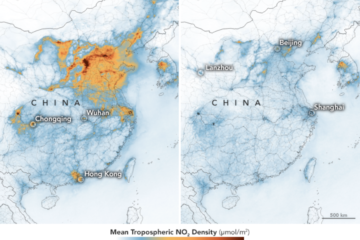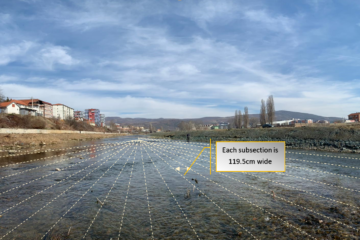
Air pollution refers to the various pollutants in the atmosphere, originating from a range of sources such as industry, transport/traffic, agriculture or households. Air pollutants can be suspended directly into atmosphere (primary emission pollutants) or can be formed as result of complex chemical reactions occurring in the atmosphere (secondary emission).
- Primary emission pollutants – sulphur-dioxide (SO2) or nitrogen-monoxide (NO), contaminants emitted directly into atmosphere from its sources
- Secondary pollutants – ozone (O3), contaminants formed as a result of chemical reaction.
Beside gases, air pollution occurs in the form of solid particles or fine dust. These particles can contain a number of components, including metals and soil or dust particles. This type of air pollution is extremely dangerous because those particles are invisible and can easily penetrate through human respiratory system and enter the lungs or even bloodstream.
Size of PM10 and PM2.5 particles|
The size of those particles is measured in micrometers and in general are separated in two categories:
- Inhalable coarse particles – those that found in the vicinity of roads and construction sites, whose diameter is larger than 2.5 micrometers but smaller than 10 micrometers.
- Fine particles – those found in forest fires, traffic, industry and are 2.5 micrometers in diameter or smaller.

The particles affect us depending on their size. Our natural defense systems assist us by coughing or sneezing larger particles out of our bodies. But our defense systems are not always successful in keeping out smaller particles from entering our respiratory or circulatory systems, simply because they pass undetected through our nose or mouth, due to their size.
For illustration purposes, if a human hair has 50-70 micrometers in diameter than we can easily calculate that PM2.5 (2.5 micrometers) particle is 30-40 times smaller than the dimeter of human hair, invisible to human eye.
Adverse health effects
Long-term exposure to air pollution has been associated with a set of adverse health effects. The risk of air pollution caused by small air particles (PM10 and PM2.5), is increased in Mitrovica which has a long history of air pollution and is notorious in that regard, in the past primarily from Trepca Industrial complex and presently by another source of pollution – air pollution caused by town traffic.
Traffic is a major source of air pollution in towns. Air pollutants are emitted from vehicle engines into the atmosphere in substantial quantities, along with CO2 emission, which causes a grave issue to environment and health of the inhabitants.
Many studies have warned about negative effects the particulate matter (PM) can have on the living world. For example a study conducted in Germany showed that the exposure of an animal model to PM was associated with increased chances for developing arteriosclerosis (Suwa et al. 2002). Another study conducted also in Germany showed that the older population has higher chances of getting a higher blood pressure when exposed to higher levels of air pollution (Ibald-Mulli et al. 2001).
A study conducted in USA showed the existence of mechanism which may lead patients to acute or chronic vasoconstriction and atherosclerosis, due to systemic inflammation or oxidative stress (Zanobetti et al. 2004).
Air pollution increases the risks of many disease, including some types of cancer[1], psychological disorders[2], cardiovascular[3] and pulmonary[4] diseases. It can also cause or worsen asthma and chronic bronchitis in children[5]. According to the Belgium government data, there are 632 premature deaths per year only in Brussels that are caused by air pollution[6].
[1] “Residential Traffic Exposure and Childhood Leukemia: A Systematic Review and Meta-analysis” Boothe, Vickie L.; Boehmer, Tegan K.; Wendel, Arthur M.; Yip, Fuyue Y. American Journal of Preventive Medicine, April 2014, vol. 46
[2] Shuai Chen, Paulina Oliva, Peng Zhang, NBER Working Paper No. 24686, June 2018
[3] Rice MB, Thurston GD, Balmes JR, Pinkerton KE. Climate change. A global threat to cardiopulmonary health. Am J Respir Crit Care Med. 2014;189:512–519
[4] Young MT, Sandler DP, DeRoo LA, et al. Ambient air pollution exposure and incident adult asthma in a nationwide cohort of U.S. women. Am J Respir Crit Care Med. 2014;190:914–921
[5] Sheffield PE, Zhou J, Shmool JL, Clougherty JE. Ambient ozone exposure and children’s acute asthma in New York City: a case-crossover analysis. Environ Health. 2015
[6] http://document.environnement.brussels/opac_css/elecfile/PLAN_AIR_CLIMAT_ENERGIE_FR_DEF.pdf


